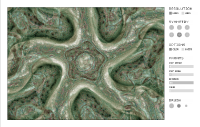Werkmodul/Fachmodul
Lecturer: Martin Schneider
Credits: 6 ECTS, 4 SWS
Date: Block-Workshops
Venue: Marienstraße 7b, Room 204
First meeting: 2013-11-29
Description
This course tackles several forms of self-organisation.
The subject is approached via exercises and experiments in the Processing programming language.
The three subject areas are:
- Pattern Formation (Cellular Automata and Turing Patterns)
- Dynamic Self-Organisation (Swarm-Art)
- Self-Assembly (Geometric Physics and Chemistry)
Beschreibung
Dieser Kurs setzt sich mit verschiedenen Formen der Selbst-Organisation auseinander.
Das geschieht in Form von Übungen und Experimenten mit der Programmiersprache Processing.
Die drei Themengebiete sind:
- Muster-Bildung (Zelluläre Automaten und Turing Patterns)
- Dynamische Selbst-Organisation (Swarm-Art)
- Selbst-Konfiguration (Geometrische Physik und Chemie)
Language
The course will be in English, unless all participants are speaking German.
Evaluation
- Regular and active participation in all three workshop blocks.
- Working on subtasks and presenting them with documentation on the wiki and on OpenProcessing
- Autonomous preparation of the course involving self-study of the relevant skills (such as programming in Processing)
- Final Assignment: Individual exploration of self-organisation with documentation on the wiki
Eligible Participants
Undergraduates and graduates enrolled in the faculties of Media, Gestaltung and Architecture.
Requirements
Applicants should have some programming experience and feel comfortable with the Processing IDE.
Application
Please sign up on the official list at the secretary with Daniela Dembowski.
All applicants are encouraged, to send an email
To: Martin Schneider
Subject: Self-Organisation by Design /// Application
Please provide a short answer to the questions below:
- What's your programming expertise? (Programming languages, generative works, projects ...)
- What do you already know about self-organisation (Books you read, related courses you took)
- What kind of computational processes are you most interested in? (Cellular Automata, Swarm Systems ...)
- What kind of patterns in nature would you like to learn more about?
Syllabus
This is an outline of the syllabus.
The dates are fixed, but details of the course may be subject to change.
| Block | Date | Day | Topics |
|---|---|---|---|
| Computational Systems | 29.11.2013 | Fri | Cellular Automata |
| 30.11.1013 | Sat | Particle Systems | |
| 01.12.2013 | Sun | Vector Fields | |
| Geometric Systems | 06.12.2013 | Fri | Swarm Art |
| 07.12.1013 | Sat | Geometric Physics | |
| 08.12.2013 | Sun | Geometric Chemistry | |
| Natural Systems | 13.12.2013 | Fri | Patterns in Nature 1 |
| 14.12.1013 | Sat | Patterns in Nature 2 | |
| 15.12.2013 | Sun | Patterns in Nature 3 |
Literature
Processing
- Bartmann, Erik: Processing: kreativ programmieren mit Processing; für Designer, Künstler und Geeks; visuelle Welten gestalten ISBN 978-3-89721-997-7
- Greenberg, Ira Processing: Creative Coding and Computational Art ISBN 9781590596173
- Hartmut Bohnacker, Benedikt Groß, Julia Laub (herausg.: Lazzeroni, Claudius): Generative Gestaltung: Entwerfen. Programmieren. Visualisieren. ISBN 978-3-87439-759-9
- Maeda, John: Creative Code: Ästhetik und Programmierung am MIT Media Lab ISBN 3764371080
- Maeda, John: Maeda@media ISBN 0500282358
- Noble, Joshua: Programming interactivity: a designer's guide to processing, Arduino, and openFrameworks ISBN 0-596-15414-3
- Pearson, Matt: Generative Art - A Practical Guide Using Processing, 2011 Manning, ISBN 978-1935182627
- Reas, Casey; Fry, Ben: Processing: A Programming Handbook for Visual Designers and Artists ISBN 978-0262182621
- Reas, Casey; McWilliams, Chandler: Form+Code in Design, Art, and Architecture ISBN 978-1568989372
- Shiffman, Daniel Learning Processing: A Beginner's Guide to Programming Images, Animation, and Interaction ISBN 9780123736024
- Terzidis, Kostas: Algorithms for visual design using the processing language ISBN 978-0-470-37548-8
Links
Processing
Check out the Processing/Links Processing Links in this Wiki if you are new to Processing.
Make sure to get comfortable with the Processing IDE before the course, so we can dive right into the code.
Virtual Classroom
Open Processing is a website for learning Processing and sharing sketches.
The virtual classroom "Self-Organisation by Design" will be
used extensively both during the course, and to publish your assignments.
Inspiration
Below is a list of resources provided by scientists, artists and designers, that rely heavily on nature inspired self-organisation in their work.
Self-Organisation Collection
Martin Schneider has created four collections of Processing sketches to give you an impression what self-organisation in software can look like.
The Nature of Code
Daniel Shiffman has published a Processing book on Natural Systems, that is available online.
Some chapters are quite relevant to the kind
of systems we are going to explore in our course.
Inspired by the Nature of Code, Diana Lange did her own explorations of Natural
Systems.
Her works are an excellent example of what you can achieve with Processing given the right combination
of artistic and programming skills, dedication to the subject and a good eye for visual detail.
Nervous System
Jessica Rosenkrantz and Jesse Eisenberg are making use of self-organisation to generate 2D and 3D printable forms.
Their work relies on scientific models of growth, such as Diffusion Limited Aggregation and Laplacian Growth which we will explore in our course.
Jonathan McCabe
Jonathan McCabe is a scientist who uses self-organisation to create art.
His works are visually stunning and unique, and the code behind them is a well-kept secret.
However the open source community has managed to recreate some of his algorithms in Processing.
We will study those algorithms and explore the kind of patterns they can create.
